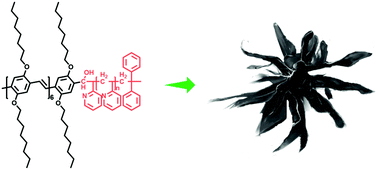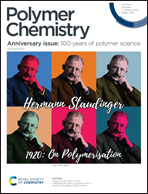Inky flower-like supermicelles assembled from π-conjugated block copolymers†
Abstract
Flower-like hierarchical nano-/meso-structures assembled from different kinds of materials have great application potential due to their advantages of high surface-to-volume ratios, high loading and adsorption capacities. These biomorphic superarchitectures are commonly obtained using inorganic, organic–inorganic hybrid and block copolymer (BCP) materials. However, the self-assembly of functional π-conjugated BCPs with weak intermolecular interactions has rarely been realized through a facile approach; moreover, the corresponding studies on how the polymer properties and assembly conditions influence the ultimate dimensionality and morphology of micelles are also scarce. Herein, we report the realization of inky flower-like hierarchical supermicelles taking advantage of the ultrashort corona block in the system of poly(2,5-di(2′-octyloxy)-1,4-phenylenevinylene)7-block-poly(2-vinylpyridine)n (PPV7-b-P2VPn). The dimensionality and morphology are successfully controlled by altering the block ratio of BCPs and the polarity of the selective solvent. Then, the growth process of the flower-like supermicelles is observed from the initial flower heart to the final flower petals. Furthermore, it is demonstrated that the formation of micelles is driven by the π–π interactions between the PPV7 blocks. Our study on constructing and regulating hierarchical supermicelles in a new functional π-conjugated system would be valuable to other BCPs-based assembly systems.



 Please wait while we load your content...
Please wait while we load your content...